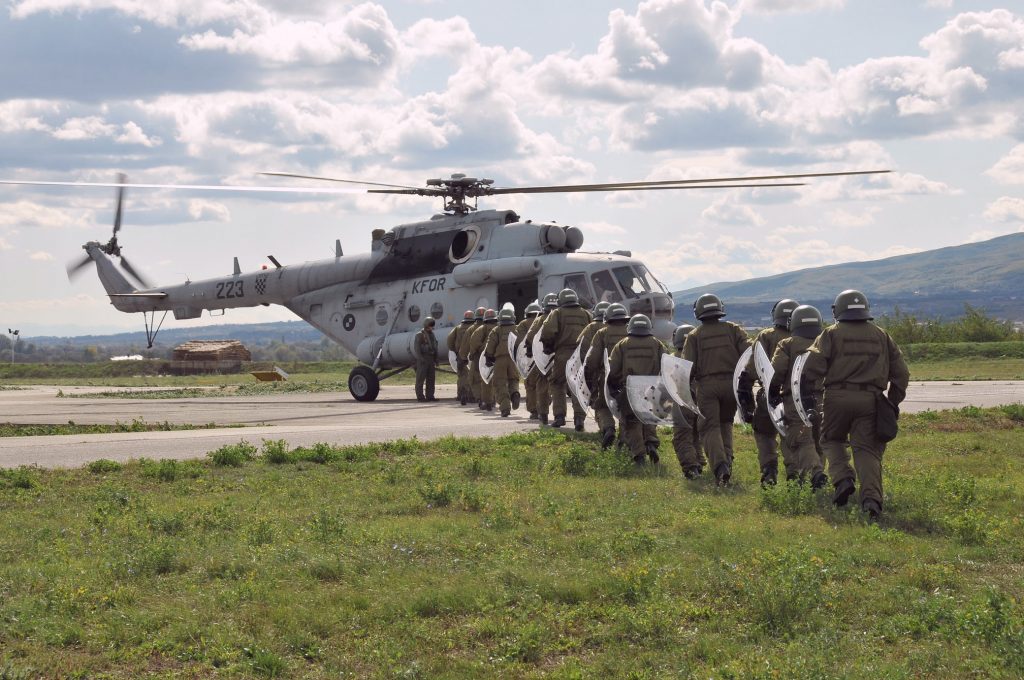It’s just embarrassing in many ways – for the Croatian political elite, for the Israeli programme officials involved and for the Croatian pilots who now have to risk their lives again in the worn-out MiG-21. The question in the title – “What now? – is followed by the sobering answer “Back to the beginning”.
In February, the Croatian Prime Minister Andrej Plenković had to justify himself before the Zagreb Parliament because of the failed purchase of the Israeli fighter aircraft F-16 BARAK. He stressed that he fully supported the strongly criticised Defence Minister Damir Krstičević as all activities related to the purchase had been carried out transparently and lawfully, and he reminded Parliament that one of the reasons why the purchase of the fighter aircraft had been started in the first place was a botched Ukrainian overhaul of the outdated MiG-21 in 2013, when the government was led by the Social Democrats.
Wild Allegations
Plenković said during a debate on the motion supported by the SDP: “The government rejects all allegations in the motion for a debate on the failed jet purchase as unfounded and false and proposes that Parliament reject the conclusions of the motion. Such a motion for the unsuccessful overhaul of MiG jets had not been filed, although the case was then the subject of legal proceedings in both Croatia and Ukraine.”
Although the opposition tried to make political gains, it had to make some concessions when it came to the fluctuating number of jets: “Your government has reduced one of the most important strategic decisions to a cheap PR exercise and crisis communication. With your lack of transparency, you have given new arguments to the numerous opponents of the plan to buy fighter planes, thus endangering the future of the Croatian Air Force (HRZ) and national security. How can you trust your plans if you want more used aircraft one day and fewer new jets the next? You are no better than those who think that the skies over Croatia should be handed over to Italians and Hungarians,” said Nikola Grmoja of the opposition MOST party.
Another opposition member, HRAST MP Hrvoje Zekanović, added that Defence Minister Krstičević had done a good job, while it was the prime minister and the president who failed: “You didn’t lobby President Trump!” Citing military analysts, he further claimed that “NATO’s strategy did not foresee Croatia having its own combat aircraft.”
Prime Minister Plenković rejected opposition allegations that the failed jet purchase jeopardised Croatia’s security and position in the international community, adding that the allegations were based on superficial assessments, a lack of understanding of the issue, and political opportunism.
No Aircraft for Croatia
Defence Minister Damir Krstičević recalled that “in connection with the US approval for transfer by third parties (TPT) I would like to stress that the country that sells the military equipment, in this case Israel, is responsible for obtaining approval for TPT. Croatia was aware from the outset of the need to obtain approval for TPT, but it is impossible to completely eliminate all risks in the process. The public has been informed about every step of the procurement process, including the difficulties in obtaining approval for TPT”.
Diplomats and military personnel from all sides involved, including the US ambassador to Croatia, Robert Kohorst, repeatedly stressed that Croatia’s international reputation had not suffered. Kohorst contradicted media claims that the US never advised Croatia not to buy the Israeli F-16s, and both the US and Israel stressed that they wanted to further expand NATO and partner relations with Croatia and deepen their defence cooperation with the Western Balkans nation. The Israeli Ministry of Defence publicly stated that Croatia demonstrated professionalism and sound judgment at every stage of the process, but was not responsible for the outcome of the process, as confirmed by the US.

However, Croatian officials have informed the local media that the US Government accused Israel of unfair competition; the Americans had also offered their own used F-16s to Croatia in the tender. Other bidders were Greece, which also offered used F-16s, and Sweden’s FMV, which offered JAS 39 GRIPEN fighters. After the failure of the Israeli BARAKs, it is likely that the equally unfortunate US Government could offer improved F-16Vs or even newly built F-16 Block-70s at a good price, ruining Saab’s last hope of selling GRIPEN in Eastern Europe or the Balkans. It is noteworthy that a decade ago the GRIPEN lost – quite unexpectedly – to various F-16s in Romania and Slovakia, and it is likely to do so again in Bulgaria. Although the GRIPEN might even have been the better solution for these nations, the political importance of their country of origin, Sweden, proved once again to be too small when compared to the “security orientation” towards the USA.
Over 1,000 E-mails
The Croatian news agency HINA reported on a “non-paper” of the American embassy in correspondence with Deputy Defence Minister Petar Mihatov, with which the embassy allegedly “warned” against procuring the used F-16s from Israel. Mihatov replied: “During the award procedure there were many official and unofficial communications, as well as many questions which we solved in consultation with our partners, because it was a very complex project. In such a complex process, in which over a thousand e-mails were exchanged, there was demanding correspondence at several levels. We had a number of additional consultations with both the American and Israeli sides. What is crucial, however, is what is stated in all official documents that Israel, as the selected bidder, had an obligation to obtain the US licence to which it officially committed itself when accepting the bid by attaching a provisional licence. The only important thing is that the US has not prohibited the sale of Israeli aircraft to Croatia in any official document, but has issued the official provisional licence required for the initial validity of the Israeli offer”.
TPT as the Breaking Point
At midnight on 5 January, the deadline set by the US State Department for Israel to officially respond to the US demand for the removal of all non-American technologies from aircraft sold to the HRZ expired. According to Israeli sources, Israel did not send an answer to the Americans. When Zagreb found that the obstacles were mounting, Croatia established its own deadline for Israel to deliver the aircraft; Croatia clearly noted that it was up to Israel to obtain US approval to deliver the aircraft. When Israeli Prime Minister Benjamin Netanyahu met US Secretary of State Mike Pompeo in Brazil at the inauguration of the new President Javier Bolsonaro, he noted that Israel was “not ready to remove all Israeli equipment from the F-16s” and de facto confirmed that it could not supply Croatia with the F-16 in the desired configuration.
The Israeli Air Force had about 125 BARAKs in service; at the time these were the backbone of the combat strength of the service. About 48 of these aircraft are two-seater D-models. These are fully missionised and have the same combat capabilities as the single-seaters, although the D-models carry a little less fuel internally and have slightly different handling characteristics at the outer edges of its flight envelope. Israel has upgraded this fleet several times, including improvements to its mission systems, cockpit displays, HUD and structures. Further EW upgrades were probably also part of this series of modifications and other upgrades, including those required to make the aircraft fully NATO/Europe compatible for Croatia.
Israel’s offer to Croatia has changed significantly over the course of 36 months. Originally, F-16A/B models were to be offered, and then a so-called mixed fleet with F-16C/D models was also considered. In the end, it seemed that Croatia chose only two-seater D-models with their characteristic equipment tunnel between cockpit and stern. These two-seater aircraft are particularly appreciated by the Israeli Air Force and have proven their worth several times in operation.
It was therefore not an option for anyone to remove the considerable amount of deeply embedded EW and target systems that Israel Aircraft Industries (IAI) and ELBIT had installed since the end of the 1908s in the F-16s and return the jets to their original condition before selling them to Croatia. The Croatian MoD had even stressed several times that these changes were decisive for its choice. “This aircraft meets our needs,” confirmed Davor Tretinjak, official of the MoD, in 2018.

In the end, everything collapsed when the outgoing US Secretary of Defense James Mattis refused in one of his last official acts to soften the US conditions for the transfer of the aircraft. Israel then announced that it had not received US approval for the TPT. This was the moment when Croatia decided to cancel the acquisition of the 12 former Israeli AF jets for about US$500M (HRK2.9Bn) to be repaid over a 10-year period. Nevertheless, the government had to admit that no guarantees were obtained during the planned purchase, as this type of procurement does not require guarantees. At the same time, the MoD announced that the next attempt to buy fighter aircraft would place more emphasis on the interdepartmental nature of the process.
The Croatian MiG-21 Saga
The author, who lives in Vienna, has been acquainted with the Croatian MiGs since Rudi Peresin flew a JRV MiG-21 to Klagenfurt in 1991 (to return to Croatia one week later, only to die three years later when shooting over the Save border). While his MiG-21R is still in the Air Force Museum on the Zeltweg, the author briefly did some research in Zagreb-Pleso in in the 1990s, because rumours were circulating that the up to 40 MiG jets used in 1995 from the former East German NVA inventory had found their dark way into embargo country, although it was later found out that they had been acquired in Ukraine.
Like many other FISHBED users, the Croatian AF suffered losses – not at the terrible speed of the Indian AF, but nonetheless painful given Croatia’s small fleet. In September 2010, two MiG-21s collided and crashed, with the two pilots successfully ejecting. In 2013, the unique and striking red and white checkerboarded MiG-21UM ‘165’ lost its rear canopy in flight.
And when pilot Stanko Hrženjak took a burning MiG-21 – not one of the 12 soon to be overhauled in Ukraine – to a controlled crash in an unpopulated area having successfully ejected, now retired general and former Croatian “air chief” Josip Štimac stressed that the MoD and the HRZ should create conditions for military pilots so that Croatia would not lose its air defence capability. Referring to Slovenia and the Baltic States, he recalled that “Croatia must not lose this capability under any circumstances, and I hope that the relevant people in our government and armed forces understand this problem and will address it seriously.”

For many years, there was no funding and no political will for a replacement, and two attempts were made to modernise the dwindling fleet. Croatia initially placed an order for the overhaul of the Romanian Aerostar, which included the modernisation of eight MiG-21bis fighter jets. The company also supplied four further developed UMD model two-seaters. This was back in in 2003, with a prolonged service life of 10 years or a warranty as to the “expiration date”.
Ten years later and still without any tangible political commitment on the radar, Croatia approached Ukraine, and in April 2014 the HRZ from Odessa received the first MiG-21bis fighter aircraft to be upgraded from Pleso Air Base near Zagreb. Seven Croatian jets – now MiG-21bis-D (in Croatian “D” stands for “Doraden” or “Modified”) – were initially overhauled by the Ukrainian state company Ukrspecexport under a contract worth €13.9M signed in June 2013. In addition to the NATO and ICAO standards, the agreement also included the supply of five additional single-seaters, which were converted and equipped according to the specifications of the Croatian Air Force. A Ukrainian team of experts supported the Croatian engineers and technicians in reassembling the aircraft in Croatia and prepared the aircraft for final testing and acceptance by HRZ.
The last aircraft was delivered in July 2015, after the Air Force had conducted flight tests. However, the delivery of the entire fleet was delayed due to problems with the integration of new navigation and communication devices and challenges posed by analogue-to-digital signal conversion.
In fact, according to the author’s sources in Croatia, problems began to crop up since the arrival of the planes. In early 2016, only three aircraft were available for operation, while five were not operational. Investigators found that some serial numbers on the airframes had been changed to Algerian and that the changed parts did not correspond to those listed in the documents, giving rise to the suspicion that the additional aircraft and/or parts could be much older than indicated by the accompanying documents supplied by the Ukrainian company. It was then examined and confirmed that the modernised FISHBEDs did indeed contain old parts from Bulgaria, Algeria and the former USSR. To make matters worse, the Yemeni Air Force (now wiped out by Saudi and UAE attacks) complained that five of the jets procured by Croatia were actually still in Yemen’s possession, even though Yemen had left these aircraft sitting unpaid for in the Odessa repair plant for years.
Therefore, Croatia then returned four of the repaired MiG-21s due to malfunctions caused by sloppy work, such as fuel leaks and defective navigation equipment. To make matters worse, in February 2018 Croatian media reported that the District Court of Zagreb was considering a case of corruption in the repair of the aircraft in Ukraine. The Bureau for Combating Organised Crime of the Croatian Ministry of Justice had accused two people of receiving bribes in the purchase and repair of the 12 MiGs purchased at the Odessa Aircraft Repair Plant.
Croatian sources later reported to the author that Zagreb had claimed contractual penalties as a result of late delivery and that the daily availability of aircraft had again fallen to less than the fingers on one hand.
Regarding the upgrades in Romania and Ukraine, however, Gen. (ret.) Štimac said these were desperate short-term solutions and the HRZ would need a long-term solution for the Croatian Air Force for the next 30, 40 or 50 years. “We need a professional debate, and this recent crash should awaken Croatia – not only the public, but above all the people who care about Croatia’s future – to see what we should do above our heads in the next 30, 40 years.”
Due to 15 years of delays in the acquisition of a new jet squadron and the unsuccessful overhaul of the current MiG-21s in Ukraine, the HRZ now has on average only three to four fully operational aircraft, which is the very minimum. If the capability of the HRZ continues to be compromised or unsafe, Croatia has no choice but to inform NATO’s command of its inability to control its skies and demand that responsibility be assumed by the air arm of one of the neighbouring Member States.
Showing Determination
The Croatian president is determined that this will not happen: “We will learn lessons from this, but we are determined to modernise the Air Force and we will launch new activities to that end. We will launch a new call for tenders for fighter aircraft to provide Croatia with the high-quality multipurpose aircraft it needs to monitor its airspace and contribute to the Alliance. Our government will do everything in its power to make this happen.” And President Plenković addressed the opposition in Parliament: “Thanks to the Lord neither you nor these people of MOST will ever be able to decide anything that concerns the government, neither the Air Force nor foreign policy. These are nothing but the dreams of you people who use these issues to attract public attention without providing arguments or having technical knowledge.”

Rotory Modernisation
In developments parallel to the messed up fighter acquisition, the Croatian MoD is adding to the HRZ equipment with second-hand BLACK HAWK UH-60 helicopters. Defence Minister Krstičević met HRZ pilots at the Pleso Air Base last year and informed them that the Ministry was working on a tactical-technical study on the acquisition of multipurpose helicopters. The study, which has not yet been published, will show which helicopters are best suited to the needs of the armed forces. It is planned to receive a squadron of new transport helicopters by 2025, when the current Mi-8 helicopters will be phased out. The aim is to switch to Western aviation technology in the next few years, with the exception of the 10 newly built Mi-171Sh transport helicopters, purchased as a partial payment for Soviet debt; they are currently undergoing a general overhaul and will remain in service for another 10 years.
The purchase of BLACK HAWK helicopters has been debated since 2014, when former Minister of Defence Ante Kotromanović discussed the idea with former US Vice President Joe Biden. The aim was to make Croatia more independent from Russian technology. According to unofficial sources, in 2015 the US Government submitted its offer for the new BLACK HAWK UH-60 model-M and for the used and overhauled UH-60 model-A, which – similar to Austria – will be upgraded to model-L. The new UH-60 model-M will be available in the near future.
The US Government also submitted an offer for 16 new Bell UH-1Y VENOM helicopters worth HKR760M. In addition, several other manufacturers have presented their products in recent years. However, in 2016 it was determined that Bell helicopters were too expensive for Croatia.
The Croatian MoD was subsequently invited to send a request to the US for a donation of 12 UH-60 model-A helicopters, as part of the Excess Defense Articles (EDA) partner programme. Through this programme, the US military donates or sells its defence surplus to partner countries. This way, the Croatian Army has already received MRAP and M-ATV vehicles and 16 surplus OH-58D KIOWA WARRIOR light helicopters. Delivered by ship to Zadar-Zemunik from August 2016 on, in September 2017 the latter successfully conducted the first tactical live firing and rocket launching within the 93 Squadron which involved 12.7mm MGs, 70mm HYDRA unguided rockets, HELLFIRE training rounds and Heckler & Koch G36CV guns.
The A-model of the BLACK HAWK is the original version of the helicopter; it has a crew of four and a transport capacity for 11 passengers. It was produced from 1977 to 1989, while the upgraded model flew until 2002 and is equipped with larger rotor blades ensuring higher lift and carrying capacity, digital avionics, including an early glass cockpit (the obsolete and unsupported Rockwell-Collins displays of which are forcing Austria to renew the cockpits with US supplier ACE Aeronautics’ ACEHAWK concept), and a more advanced computer flying system. If these plans are put into practice, it would mean that the process of replacing Russian technology with Western equipment in another “new” NATO member is almost complete.
Georg Mader is a defence correspondent and freelance aerospace journalist based in Vienna, Austria, and a regular contributor to ESD.











